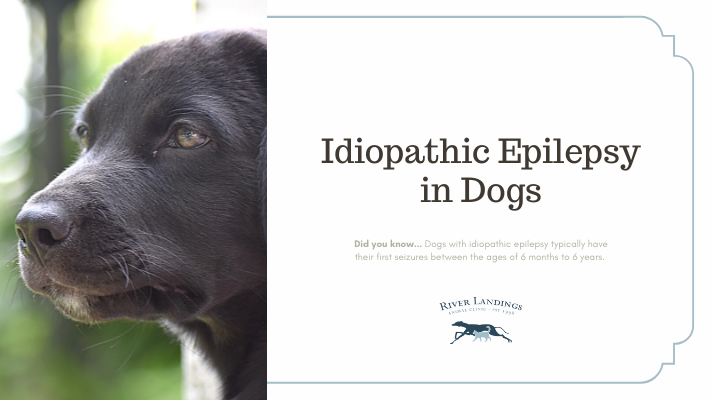Epilepsy is a general term for neurological disorders that are characterized by recurrent seizures. In some cases, the seizures are caused by trauma, a toxin, a brain tumor, an infection, or an issue with your dog’s blood, kidneys, or other organs. At other times, the epilepsy is referred to as “idiopathic,” which simply means that there is no identifiable, underlying cause.
Seizures commonly fall into two categories: generalized (grand mal) or partial (focal). Generalized seizures commonly appear as involuntary jerking or twitching movements of all four limbs with loss of consciousness. Partial seizures may involve one limb, side of the body, or face. Partial seizures may progress to generalized seizures. Seizures may also result in abnormal behavior, vocalization, salivation, chomping/chewing, and involuntary urination and defecation.
Dogs with idiopathic epilepsy typically have their first seizures between the ages of 6 months to 6 years. Though idiopathic epilepsy can occur in any breed, it is considered an inheritable disease in many breeds and in some breeds a genetic basis has been identified. Therefore, dogs diagnosed with idiopathic epilepsy should not be used for breeding. Commonly affected breeds include:
Labrador retrievers
Golden retrievers
Poodles
Keeshonds
Beagles
German shepherds
Dachshunds
Irish setters
Cocker spaniels
Symptoms of Epilepsy in Dogs
Prolonged seizures lasting more than 5 minutes or two or more consecutive seizures without full recovery are referred to as status epilepticus. This is a true emergency and you should seek immediate veterinary care for you pet. Two or more seizures in 24 hours are referred to as cluster seizures and are an indication for beginning anti-seizure medication.
In dogs, seizures often occur in three distinct phases:
The first is called the aural phase and the most common signs are behavioral changes. These changes may be subtle and include restlessness, attention seeking or anxious behavior.
The second phase, called the ictal phase, is when the seizure itself takes place. A seizure can last from just a few seconds to several minutes.
The final phase is called the postictal phase, which occurs after the seizure. During this phase, your dog may seem restless, incoordinated and/or disoriented. Occasionally, temporary blindness, deafness or other neurologic abnormalities may occur.
It may be difficult to watch your pet have a seizure but most are of short duration and cause no permanent harm. Avoid being bitten by keeping your hands away from your pet’s mouth during a seizure. If it can be done safely, provide padding and move your pet away from stairs to prevent injury.
Diagnosis of Epilepsy in Dogs
Your veterinarian will take a complete history and perform a thorough physical and neurological exam to determine if there is an identifiable, underlying cause of your dog’s seizure.
In order to do so, the following tests may be recommended:
Chemistry tests to evaluate kidney, liver, and pancreatic function, as well as sugar levels and electrolytes
A complete blood count to screen for infection, inflammation, anemia, and other blood-related conditions
Urinalysis
PCR testing and/or serology to evaluate for infectious diseases that may cause seizures
Referral to a neurologist for advanced testing including MRI and cerebrospinal fluid analysis
Cultures, PCR testing, and other specialized tests that can identify if specific parasites or diseases could be the cause
Treatment of Epilepsy in Dogs
Epilepsy cannot be cured, but it can usually be controlled with anticonvulsant drugs. If your veterinarian determines that your dog’s epilepsy is idiopathic, one or more of the following medications may be prescribed:
Phenobarbital helps reduce the frequency of your dog’s seizures and is the most prescribed medication for dogs with idiopathic epilepsy. It is generally a well-tolerated drug.
Potassium bromide is another seizure medication that may be added to your dog’s treatment, if she does not respond well to phenobarbital alone.
With these medications, as with all drugs, some patients experience side effects. In order to make sure an adequate dose is being given, and to monitor for side effects, it is important that blood levels of each medication as well as complete blood counts and blood chemistry profiles be monitored periodically. Liver function tests may also be indicated. Your veterinarian will advise what monitoring needs to be done and how often. Medication dosages should not be changed without talking to your veterinarian.
Dogs diagnosed with idiopathic epilepsy may require treatment for life, and sometimes more than one drug is needed for adequate seizure control. And while many dogs are well controlled, some are not despite multiple medications. In addition, adequate seizure control does not necessarily guarantee that a dog will be entirely seizure free. The degree of seizure control may need to be balanced against potential side effects of the medications.
Management of Epilepsy in Dogs
Besides medication, there are many ways for you, yourself, to help manage your pet’s epilepsy:
Maintain a seizure log that lists date, time, length and severity of seizures as well as videotape and share this with your veterinarian
Do not change or discontinue medications without consulting your veterinarian
Have blood work and other lab work done when recommended by your veterinarian
Consult your veterinarian whenever you notice a change in your pet’s condition
Put a medical alert tag on your pet’s collar so that if he becomes lost, whoever finds him will be aware of their seizure disorder and need for medication.
Several treatments are available for pets with epilepsy. By working closely with your veterinarian, you can maximize the chances of controlling the disorder and giving your pet a long, happy, and comfortable life.
Hear From Us Again
Don't forget to subscribe to our email newsletter for more recipes, articles, and clinic updates delivered straight to your e-mail inbox.
Related Categories:



